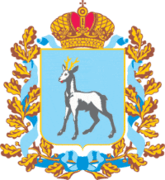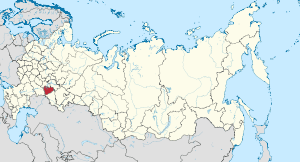Samara Oblast
| Samara Oblast Самарская область (Russian) | |||
|---|---|---|---|
| — Oblast — | |||
| |||
|
| |||
| |||
|
| |||
| Political status | |||
| Country | Russia | ||
| Federal district | Volga[2] | ||
| Economic region | Volga[3] | ||
| Established | December 5, 1936[4] | ||
| Administrative center | Samara | ||
| Government (as of December 2015) | |||
| • Governor[5] | Nikolay Merkushkin[6] | ||
| • Legislature | Governorate Duma[7] | ||
| Statistics | |||
| Area (as of the 2002 Census)[8] | |||
| • Total | 53,600 km2 (20,700 sq mi) | ||
| Area rank | 50th | ||
| Population (2010 Census)[9] | |||
| • Total | 3,215,532 | ||
| • Rank | 11th | ||
| • Density[10] | 59.99/km2 (155.4/sq mi) | ||
| • Urban | 80.2% | ||
| • Rural | 19.8% | ||
| Population (January 2015 est.) | |||
| • Total | 3,212,676[11] | ||
| Time zone(s) | SAMT (UTC+04:00)[12] | ||
| ISO 3166-2 | RU-SAM | ||
| License plates | 63, 163 | ||
| Official languages | Russian[13] | ||
| Official website | |||
Samara Oblast (Russian: Сама́рская о́бласть, tr. Samarskaya oblast; IPA: [sɐˈmarskəjə ˈobləsʲtʲ]) is a federal subject of Russia (an oblast). Its administrative center is the city of Samara. As of the 2010 Census, the population of the oblast was 3,215,532.[9]
History
Middle Volga Oblast was established on May 14, 1928.[4] On October 20, 1929, it was transformed into Middle Volga Krai, which was renamed Kuybyshev Krai on January 27, 1935.[4] On December 5, 1936, Kuybyshev Krai was transformed into Kuybyshev Oblast (Russian: Ку́йбышевская о́бласть, tr. Kuybyshevskaya Oblast; IPA: [ˈkujbɨʂɨfskəjə ˈobləstʲ]) upon the adoption of the 1936 Soviet Constitution.[4] On January 25, 1991, the oblast was renamed Samara Oblast.[14]
Administrative divisions
Demographics
Population: 3,215,532 (2010 Census);[9] 3,239,737 (2002 Census);[15] 3,265,586 (1989 Census).[16]
Ethnic groups: According to the 2010 Census, the ethnic makeup of the oblast was:[9]
- 2,645,124 Russians (85.6%)
- 126,124 Tatars (4.1%)
- 84,105 Chuvash (2.7%)
- 65,447 Mordvins (2.1%)
- 42,169 Ukrainians (1.4%)
- 22,981 Armenians (0.7%)
- 123,691 people were registered from administrative databases, and could not declare an ethnicity. It is estimated that the proportion of ethnicities in this group is the same as that of the declared group.[17]
- Births (2008): 36,439 (11.5 per 1000) [18]
- Deaths (2008): 48,593 (15.3 per 1000)
- Vital statistics for 2012
2009 - 1.42 | 2010 - 1.44 | 2011 - 1.44 | 2012 - 1.54 | 2013 - 1.59 | 2014 - 1.65 | 2015 - 1.70(e)
Economy
In 1997, Samara Oblast became one of the few federal subjects to receive the approval of the President of Russia to implement external bonded loans (Presidential decree № 1212, dated 12.10.1997 “On Creating Conditions to Conduct Loans Operations on the Internal and External Capital Markets”).
Politics
During the Soviet period, the high authority in the oblast was shared between three persons: The first secretary of the Samara CPSU Committee (who in reality had the biggest authority), the chairman of the oblast Soviet (legislative power), and the Chairman of the oblast Executive Committee (executive power). Since 1991, CPSU lost all the power, and the head of the Oblast administration, and eventually the governor was appointed/elected alongside elected regional parliament.
The Charter of Samara Oblast is the fundamental law of the oblast. The Legislative Assembly of Samara Oblast is the province's standing legislative (representative) body. The Legislative Assembly exercises its authority by passing laws, resolutions, and other legal acts and by supervising the implementation and observance of the laws and other legal acts passed by it. The highest executive body is the Oblast Government, which includes territorial executive bodies such as district administrations, committees, and commissions that facilitate development and run the day to day matters of the province. The Oblast administration supports the activities of the Governor who is the highest official and acts as guarantor of the observance of the oblast Charter in accordance with the Constitution of Russia.
Governors:
- Konstantin Titov (1991—2007)
- Vladimir Artyakov (2007-2012)
- Nikolay Merkushkin (Acting) (since 2012)
Religion
According to a 2012 official survey[21] 35% of the population of Samara Oblast adheres to the Russian Orthodox Church, 7% are unaffiliated generic Christians, 1% are Orthodox Christian believers who do not belong to any church or are members of non-Russian Orthodox churches, 3% are Muslims, and 1% of the population are adherents of Rodnovery (Slavic folk religion). In addition, 30% of the population declares to be "spiritual but not religious", 13% is atheist, and a further 10% follows other religions or did not give an answer to the question.[21]
Sister relations
References
Notes
- ↑ Law On the State Symbols of Samara Oblast
- ↑ Президент Российской Федерации. Указ №849 от 13 мая 2000 г. «О полномочном представителе Президента Российской Федерации в федеральном округе». Вступил в силу 13 мая 2000 г. Опубликован: "Собрание законодательства РФ", №20, ст. 2112, 15 мая 2000 г. (President of the Russian Federation. Decree #849 of May 13, 2000 On the Plenipotentiary Representative of the President of the Russian Federation in a Federal District. Effective as of May 13, 2000.).
- ↑ Госстандарт Российской Федерации. №ОК 024-95 27 декабря 1995 г. «Общероссийский классификатор экономических регионов. 2. Экономические районы», в ред. Изменения №5/2001 ОКЭР. (Gosstandart of the Russian Federation. #OK 024-95 December 27, 1995 Russian Classification of Economic Regions. 2. Economic Regions, as amended by the Amendment #5/2001 OKER. ).
- 1 2 3 4 Administrative-Territorial Structure of the Union Republics. 1987., p. 162
- ↑ Charter of Samara Oblast, Article 61
- ↑ Official website of Samara Oblast. Biography of the Governor of Samara Oblast (Russian)
- ↑ Charter of Samara Oblast, Article 59
- ↑ Федеральная служба государственной статистики (Federal State Statistics Service) (2004-05-21). "Территория, число районов, населённых пунктов и сельских администраций по субъектам Российской Федерации (Territory, Number of Districts, Inhabited Localities, and Rural Administration by Federal Subjects of the Russian Federation)". Всероссийская перепись населения 2002 года (All-Russia Population Census of 2002) (in Russian). Federal State Statistics Service. Retrieved 2011-11-01.
- 1 2 3 4 Russian Federal State Statistics Service (2011). "Всероссийская перепись населения 2010 года. Том 1" [2010 All-Russian Population Census, vol. 1]. Всероссийская перепись населения 2010 года (2010 All-Russia Population Census) (in Russian). Federal State Statistics Service. Retrieved June 29, 2012.
- ↑ The density value was calculated by dividing the population reported by the 2010 Census by the area shown in the "Area" field. Please note that this value may not be accurate as the area specified in the infobox is not necessarily reported for the same year as the population.
- ↑ Samara Oblast Territorial Branch of the Federal State Statistics Service. Численность населения по полу и возрасту на 1 января 2015 года, Самарская область (Russian)
- ↑ Правительство Российской Федерации. Федеральный закон №107-ФЗ от 3 июня 2011 г. «Об исчислении времени», в ред. Федерального закона №271-ФЗ от 03 июля 2016 г. «О внесении изменений в Федеральный закон "Об исчислении времени"». Вступил в силу по истечении шестидесяти дней после дня официального опубликования (6 августа 2011 г.). Опубликован: "Российская газета", №120, 6 июня 2011 г. (Government of the Russian Federation. Federal Law #107-FZ of June 31, 2011 On Calculating Time, as amended by the Federal Law #271-FZ of July 03, 2016 On Amending Federal Law "On Calculating Time". Effective as of after sixty days following the day of the official publication.).
- ↑ Official on the whole territory of Russia according to Article 68.1 of the Constitution of Russia.
- ↑ Decree #526-1
- ↑ Russian Federal State Statistics Service (May 21, 2004). "Численность населения России, субъектов Российской Федерации в составе федеральных округов, районов, городских поселений, сельских населённых пунктов – районных центров и сельских населённых пунктов с населением 3 тысячи и более человек" [Population of Russia, Its Federal Districts, Federal Subjects, Districts, Urban Localities, Rural Localities—Administrative Centers, and Rural Localities with Population of Over 3,000] (XLS). Всероссийская перепись населения 2002 года [All-Russia Population Census of 2002] (in Russian). Retrieved August 9, 2014.
- ↑ Demoscope Weekly (1989). "Всесоюзная перепись населения 1989 г. Численность наличного населения союзных и автономных республик, автономных областей и округов, краёв, областей, районов, городских поселений и сёл-райцентров" [All Union Population Census of 1989: Present Population of Union and Autonomous Republics, Autonomous Oblasts and Okrugs, Krais, Oblasts, Districts, Urban Settlements, and Villages Serving as District Administrative Centers]. Всесоюзная перепись населения 1989 года [All-Union Population Census of 1989] (in Russian). Институт демографии Национального исследовательского университета: Высшая школа экономики [Institute of Demography at the National Research University: Higher School of Economics]. Retrieved August 9, 2014.
- ↑ "Перепись-2010: русских становится больше". Perepis-2010.ru. 2011-12-19. Retrieved 2012-08-13.
- ↑
- ↑ http://www.gks.ru/free_doc/2012/demo/edn12-12.htm
- ↑ http://www.gks.ru/wps/wcm/connect/rosstat_main/rosstat/ru/statistics/publications/catalog/doc_1137674209312
- 1 2 3 Arena - Atlas of Religions and Nationalities in Russia. Sreda.org
- ↑ 2012 Survey Maps. "Ogonek", № 34 (5243), 27/08/2012. Retrieved September 24, 2012.
- ↑ Hungary and Russia sister city relationships
Sources
- Самарская Губернская Дума. Закон №22-ГД от 13 октября 1998 г. «О государственных символах Самарской области», в ред. Закона №146-ГД от 31 декабря 2014 г. «О внесении изменения в статью 2 Закона Самарской области "О государственных символах Самарской области"». Вступил в силу с момента опубликования (17 октября 1998 г.). Опубликован: "Волжская коммуна", №186, 17 октября 1998 г. (Samara Governorate Duma. Law #22-GD of October 13, 1998 On the State Symbols of Samara Oblast, as amended by the Law #146-GD of December 31, 2014 On Amending Article 2 of the Law of Samara Oblast "On the State Symbols of Samara Oblast". Effective as of the moment of publication (October 17, 1998).).
- Самарская Губернская Дума. №179-ГД 18 декабря 2006 г. «Устав Самарской области», в ред. Закона №6-ГД от 11 января 2016 г. «О внесении изменений в Устав Самарской области». Вступил в силу 1 января 2007 г. Опубликован: "Волжская коммуна", №237 (25790), 20 декабря 2006 г. (Samara Governorate Duma. #179-GD December 18, 2006 Charter of Samara Oblast, as amended by the Law #6-GD of January 11, 2016 On Amending the Charter of Samara Oblast. Effective as of January 1, 2007.).
- Президиум Верховного Совета РСФСР. Указ №526-1 от 25 января 1991 г. «О переименовании города Куйбышева в город Самару и Куйбышевской области в Самарскую область». (Presidium of the Supreme Soviet of the RSFSR. Decree #526-1 of January 25, 1991 On Changing the Name of the City of Kuybyshev to the City of Samara and of Kuybyshev Oblast to Samara Oblast. ).
External links
 Media related to Samara Oblast at Wikimedia Commons
Media related to Samara Oblast at Wikimedia Commons- Official website of Samara Oblast (Russian)
- Central Eurasian Information Resource: Images of Samara Oblast, University of Washington Digital Collection
 |
|
 | ||
| |
|
| ||
| ||||
| | ||||
| |
West Kazakhstan Province, |



